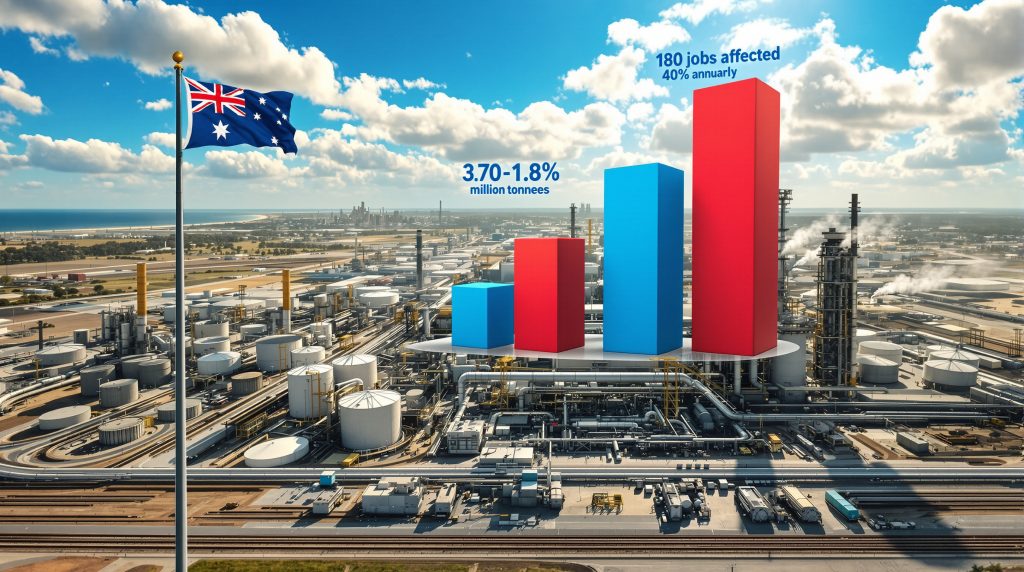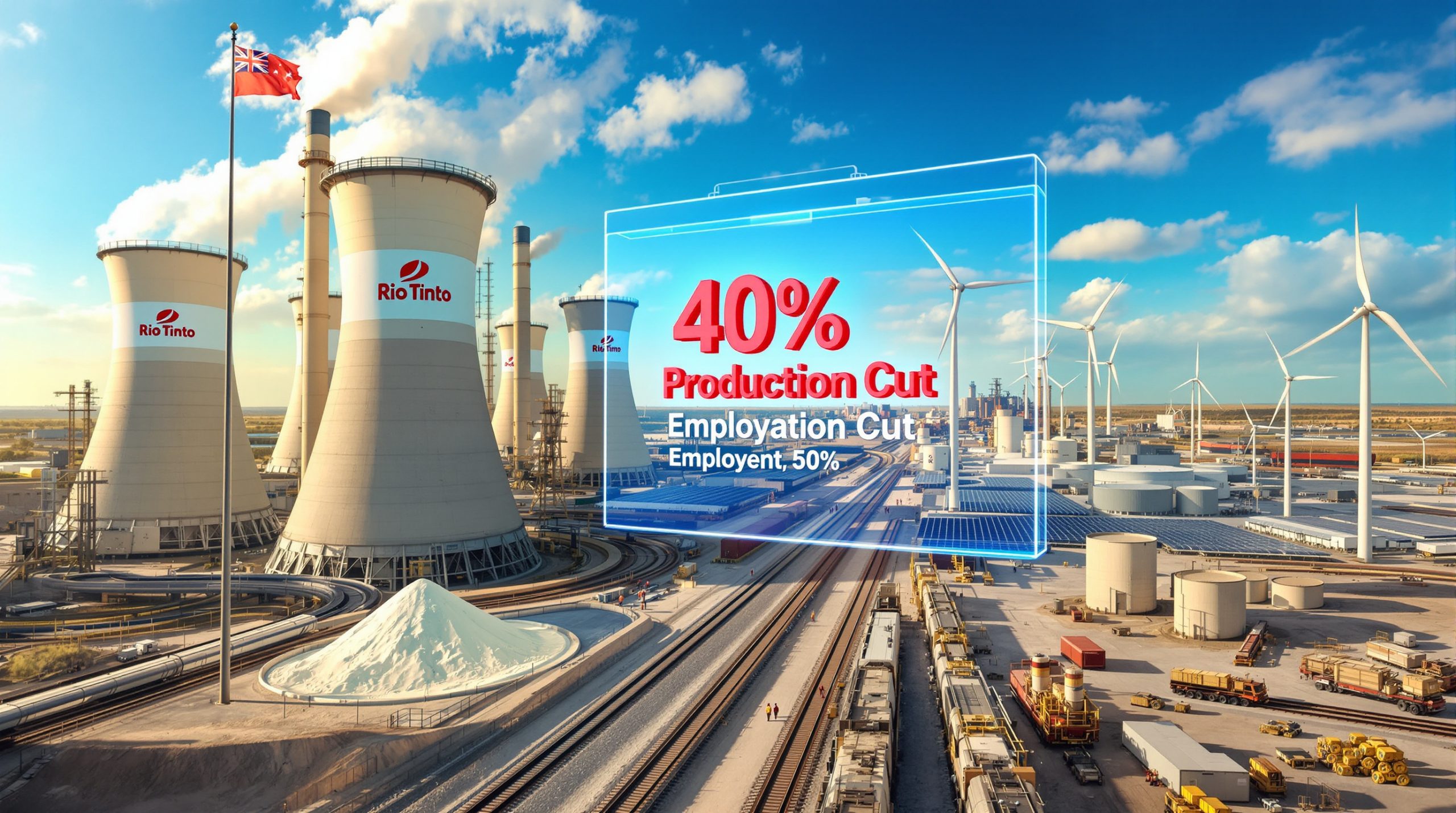Infrastructure Constraints Drive Queensland Refinery Downsizing
Rio Tinto job cuts at Queensland refinery represent a calculated response to operational challenges rather than market pressures. The facility faces a critical infrastructure bottleneck that will limit operations beyond 2031 without significant intervention.
The 40% production reduction stems primarily from tailings storage capacity reaching its maximum threshold. Current waste management infrastructure cannot support full-scale operations past 2031, forcing the company to choose between massive capital investment or operational adjustments.
This strategic pivot extends the facility's operational timeline to 2035, providing additional years to develop innovative waste management solutions while maintaining production capabilities. Furthermore, this approach aligns with the broader mining industry evolution towards sustainable operations.
Workforce Impact Analysis for Queensland Operations
The restructuring affects 180 positions from Yarwun's current workforce of 725 employees, representing approximately 25% of total staff. This reduction makes it one of the most significant employment adjustments in Queensland's alumina sector in recent years.
| Employment Metric | Current Status | Post-Reduction | Change |
|---|---|---|---|
| Total Workforce | 725 employees | 545 employees | -180 positions |
| Percentage Impact | 100% | 75% | -25% |
| Implementation Date | Current | October 2026 | 22-month timeline |
Internal Redeployment Strategy
Rio Tinto has committed to comprehensive workforce transition support through:
- Skills matching programs connecting affected workers with suitable positions across Gladstone operations
- Priority placement opportunities within the broader Rio Tinto network
- Professional development support during the adjustment period
- Collaboration with regional employment agencies to facilitate external job placement
The company's integrated operations model provides multiple facilities within the Gladstone region, potentially offering alternative employment pathways for skilled workers. Moreover, this follows similar patterns seen in Queensland coal mining job cuts across the sector.
Root Causes Behind Production Curtailment
Tailings Storage Facility Limitations
The primary driver behind these changes centers on tailings management infrastructure constraints. The existing Tailings Storage Facility (TSF) will reach maximum capacity by 2031 under current production rates, creating both operational and environmental compliance challenges.
Alumina refining through the Bayer process generates approximately 1.0-1.5 tonnes of bauxite residue for every tonne of refined alumina produced. This residue requires secure, long-term storage in specialized facilities designed to contain the alkaline waste material safely.
Consequently, companies are increasingly focusing on mine reclamation innovation to address these storage and environmental challenges more effectively.
Economic Viability Assessment
According to Armando Torres, Rio Tinto Aluminium Pacific Operations Managing Director, the scale of investment required for developing a secondary tailings facility proved economically unviable under current market conditions. The company conducted extensive feasibility studies over multiple years before reaching this conclusion.
The substantial capital expenditure required for TSF expansion does not align with current alumina market projections and return on investment thresholds.
This decision reflects broader industry challenges where aging infrastructure requires significant capital investment that may not generate adequate returns under present economic conditions.
National Alumina Production Implications
Quantified Production Impact
The operational adjustment removes 1.2 million tonnes of annual alumina production capacity from Australian output. This reduction affects both domestic supply chains and international market positioning.
| Production Metric | Current Capacity | Reduced Capacity | Annual Impact |
|---|---|---|---|
| Yarwun Annual Output | 3.0 million tonnes | 1.8 million tonnes | -1.2 million tonnes |
| Capacity Utilization | 100% | 60% | -40% |
| Operational Timeline | Until 2031 | Extended to 2035 | +4 years |
Regional Economic Considerations
Gladstone's industrial ecosystem faces adjustments as the refinery scales back operations. The reduction creates ripple effects through:
- Supplier network modifications as service providers adapt to reduced operational requirements
- Local employment patterns shifting within the heavy industry sector
- Supply chain reconfiguration affecting downstream aluminum production
The extended operational timeline provides stability for regional planning while allowing time for technological innovations to emerge. In addition, Rio Tinto's new CEO plans to streamline operations across the company's portfolio.
Strategic Operations Management
Integrated Supply Chain Continuity
Rio Tinto has emphasised that bauxite mining operations and aluminum smelting facilities will maintain full production capacity despite the refinery adjustments. This approach preserves the company's integrated supply chain model while addressing specific infrastructure constraints.
The decision raises operational questions about raw material flow and finished product supply that require careful coordination across multiple facilities. However, this aligns with modern mine planning approaches that prioritise integrated operational strategies.
Technical Innovation Focus
The extended operational timeline provides opportunity to develop innovative waste management approaches, including:
Advanced Neutralisation Systems:
- Chemical treatment processes designed to reduce tailings volume through pH adjustment
- Integration capabilities with existing waste management infrastructure
- Enhanced environmental compliance through improved waste characteristics
Centrifuge-Based Dry Tailings Technology:
- Water extraction methodologies creating drier waste products with reduced storage requirements
- Potential volume reductions of 40-60% compared to conventional wet tailings
- Improved long-term storage stability and reduced environmental risk profiles
Industry-Wide Operational Pressures
Energy Cost Challenges
The decision reflects broader challenges facing energy-intensive manufacturing operations across Australia. Rising electricity costs and infrastructure constraints are reshaping operational strategies throughout the resources sector.
Aluminum production ranks among the most electricity-intensive industrial processes, with energy costs representing approximately 30-40% of total production costs. Any significant increase in power prices directly impacts operational viability.
Furthermore, these pressures drive companies towards data-driven operations to optimise efficiency and reduce costs.
Strategic Timeline Coordination
The October 2026 implementation provides structured transition period enabling:
- Workforce adjustment programs with adequate notice and support services
- Supply chain reconfiguration allowing suppliers to adapt business models
- Market adaptation to reduced capacity with minimal disruption
This timeline coincides with broader operational restructuring across Rio Tinto's Gladstone operations, suggesting coordinated strategic planning.
Comparative Industry Context
Pattern of Operational Adjustments
The Yarwun decision follows similar strategic reviews across Australia's aluminum sector, where companies balance production capacity with infrastructure constraints and economic viability considerations.
The timing correlates with Rio Tinto's earlier announcement regarding potential early closure of Gladstone Power Station, indicating comprehensive operational restructuring within the region rather than isolated facility-specific decisions.
Infrastructure Investment Trends
This situation exemplifies industry-wide challenges where aging infrastructure requires substantial capital investment that may not generate adequate returns under current market conditions. Companies increasingly prioritise technological innovation over traditional capacity expansion.
Consequently, this approach aligns with the broader sustainable mining transformation occurring across the sector.
Technological Solutions Development
Neutralisation-Based Processing
Rio Tinto continues investigating multiple pathways to extend Yarwun's operational life beyond 2035 through advanced tailings management technologies:
- pH adjustment systems reducing alkalinity of bauxite residue for safer long-term storage
- Volume reduction technologies minimising storage footprint requirements
- Environmental compliance enhancements exceeding current regulatory standards
Advanced Dewatering Systems
Centrifuge-based dry tailings represent emerging technology offering significant advantages:
- Reduced water content in final waste products lowering storage volume requirements
- Enhanced stability of stored materials reducing long-term environmental risks
- Resource recovery opportunities through improved separation of valuable materials
These technological approaches require extensive testing and validation before commercial implementation, making the extended operational timeline crucial for development and deployment.
Community and Worker Support Framework
Comprehensive Transition Programs
Rio Tinto has outlined extensive assistance measures addressing both immediate and long-term impacts:
Employee Support Services:
- Skills assessment programs identifying transferable capabilities
- Internal job placement priority across Gladstone operations network
- Professional development opportunities during transition period
- Collaboration with regional employment agencies for external placement
Community Impact Mitigation:
- Supplier relationship management maintaining local business connections
- Business impact assessments quantifying regional economic effects
- Stakeholder engagement throughout the transition process
Regional Economic Adaptation
The company recognises broader community implications beyond direct employment effects, implementing strategies to minimise economic disruption through sustained engagement with local suppliers and service providers.
Future Industry Transformation
Innovation-Driven Solutions
The focus on advanced tailings management represents growing industry trends toward technological innovation in addressing operational constraints and environmental compliance requirements. This approach prioritises sustainable long-term solutions over traditional infrastructure expansion.
Operational Resilience Planning
The Yarwun situation highlights the importance of proactive infrastructure planning and technological innovation in maintaining operational viability. Companies increasingly must balance immediate production requirements with long-term sustainability considerations.
The extended timeline provides opportunities for breakthrough technologies to reach commercial viability, potentially transforming how the industry approaches waste management challenges. Moreover, the Rio Tinto job cuts at Queensland refinery demonstrate how strategic planning can balance operational efficiency with workforce considerations.
Disclaimer: This analysis is based on publicly available information and company announcements. Operational and financial projections are subject to change based on market conditions, technological developments, and regulatory requirements. Investment and employment decisions should consider multiple factors beyond the scope of this analysis.
Looking to Capitalise on Mining Sector Developments?
Discovery Alert's proprietary Discovery IQ model delivers real-time alerts on significant ASX mineral discoveries, helping investors identify actionable opportunities as major announcements reshape the mining landscape. Begin your 30-day free trial today to position yourself ahead of market movements and understand why historic discoveries can generate substantial returns by exploring our dedicated discoveries page.




